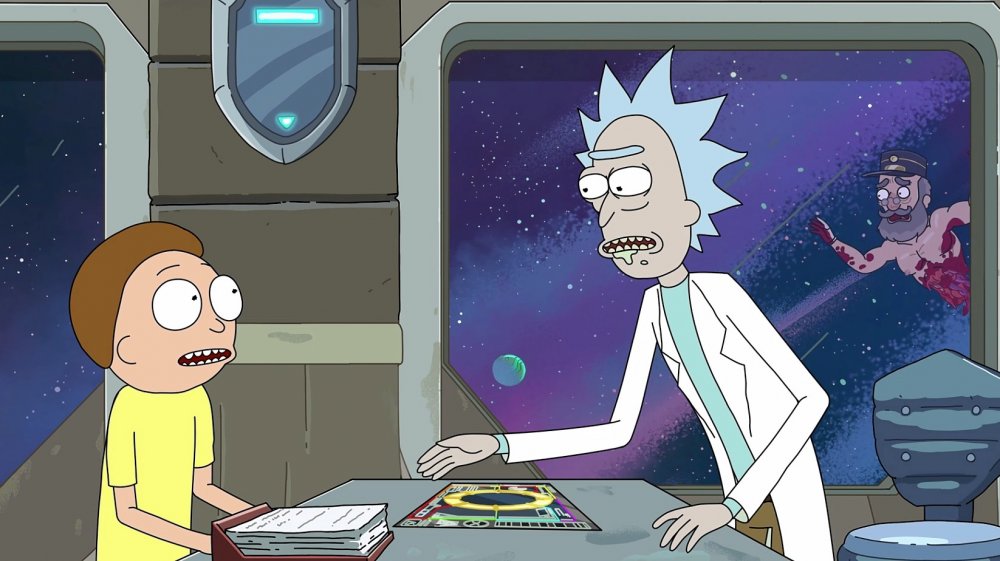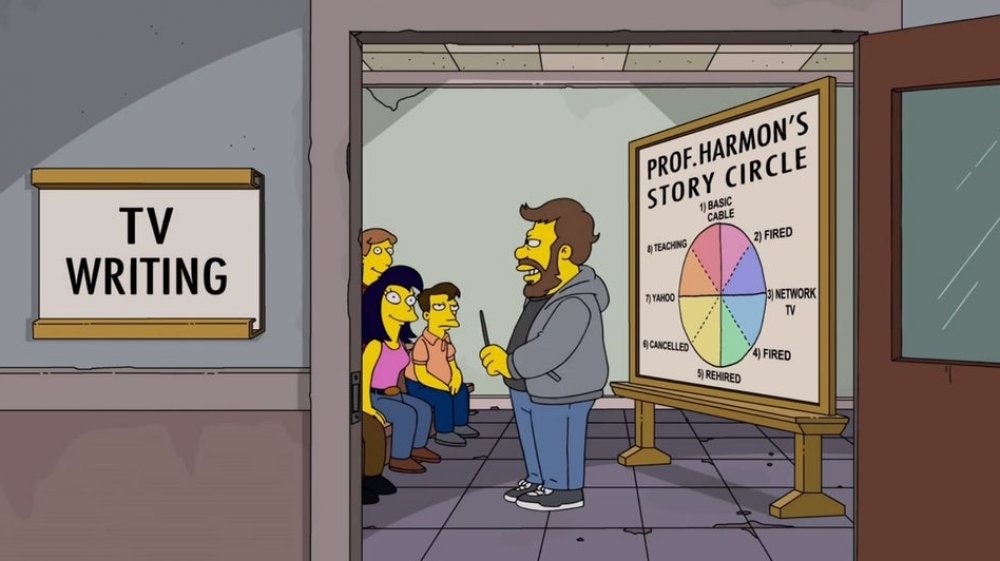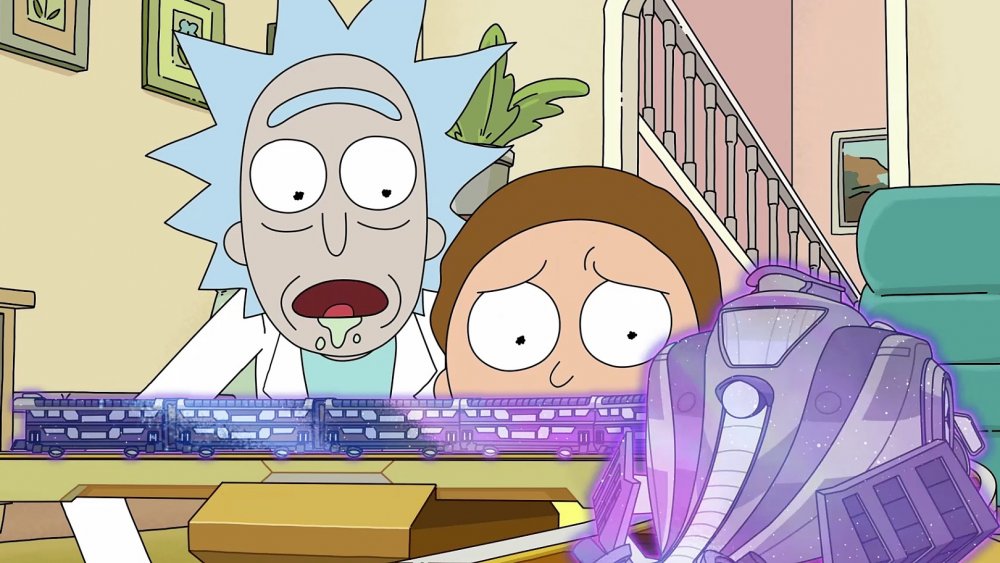The Truth About The Code In Rick And Morty's Story Train
Contains spoilers for Rick and Morty season 4, episode 6, "Never Ricking Morty."
Ricky and Morty's latest episode went off the rails — both literally and figuratively. But true to form, it was also packed with Easter eggs and pop culture references, right on down to its very story structure.
If you caught the midseason premiere, you know that the episode revolved around Rick and Morty trying to escape the Story Train, a physical and metaphorical manifestation of story devices. The two fight their way through several cars, which represent common tropes and scenarios, to get to the train's engine. But before they can stop the train and get off this wild ride, they are forced to battle the train conductor, Story Lord, who wants to mine Rick and Morty's essence for plots that will help him break the fifth wall (that's right — the fifth wall).
The two eventually defeat the Story Lord, but when Rick reaches for the controls, he realizes that they aren't responding to him. That's because they aren't real, something that becomes evident when Rick pulls the engine's various levers and buttons off like a sticker. Fans initially took "Never Ricking Morty" as a self-contained storyline, seemingly existing outside of the show's regular conventions and, most importantly, co-creator Dan Harmon's famous writing rule. Adapted from Joseph Campbell's "Monomyth" — dubbed by writer Christopher Vogler as "The Hero's Journey" — Harmon's "Story Circle" has presumably guided each episode of the Adult Swim animated series until "Never Ricking Morty."
But one eagle-eyed fan discovered a hint tucked inside the episode, revealing exactly how it adheres to these famous rules precisely by subverting them.
A sequence in the show is a reference to Dan Harmon's famed story structure
For those who aren't major fans of Dan Harmon, his "Story Circle" is somewhat legendary, and was even riffed on during an episode of The Simpsons. Harmon's structure incorporates eight different steps that take a character from their comfort zone to a pivotal change. It begins with a protagonist in a comfort zone, before they realize they want something and enter an unfamiliar situation to get it. They adapt out of said comfort zone and get what they wanted, but pay a heavy price for it. After returning to a familiar situation, they are now changed. Harmon's circle is a modification of the Hero's Journey, which involves a 12-step process by which the protagonist begins in an ordinary world before embarking on a quest, undergoing several physical or internal tests and trials, and eventually being changed. Harmon's Story Circle is a condensed and slightly modified version of the Hero's Journey. It drops steps like the hero meeting a mentor, and re-arranges others, such as the hero's return journey and a final confrontation revealing that the protagonist's battle is bigger than them.
"Never Ricking Morty" doesn't follow the patterns of either story structure exactly. But through the combined efforts of several fans, including Redditors u/basicWhiteGuy42 and u/beastofbalthazar, viewers now know that a numerical sequence spotted on the Story Train's engine control panel can be attributed to parts of both structures (via Inverse). Not only does it point directly to a set of scrambled steps for both narrative structures, but serves as a blueprint for the order in which Rick and Morty navigate the actual train cars.
The sequence in question is 02376319 — eight steps, just like the Story Circle but featuring numbers you'd also find in the Hero's Journey.
The Story Train's journey is derailed so Rick and Morty's adventures can continue
The train car scenarios represent each number in the uncovered sequence. The second car is where Rick and Morty acknowledge that they want to escape the train. It can also be interpreted as the call to adventure in the Hero's Journey, as Redditor u/beastofbalthazar notes. The third car, according to the Story Circle, sees them enter an unfamiliar situation — here, a fight with a very buff train ticket taker. Or, if you're doing a Hero's Journey interpretation, it's Rick and Morty's refusal to the call as they opt not to engage with the scenario.
As for zero, this number can be read as the first step in the Hero's Journey, with the show kicking off in a world that exists before the plot begins, its hero oblivious of the adventures to come. But if examined through the lens of the Story Circle, it could also point to another layer of wall-breaking, as it starts the episode within yet another contained story that subtly mentions Rick, the man in the white coat, as "the only creature worth killing." Because it doesn't exist in Harmon's Story Circle, nine could illustrate the episode's final wall-breaking moment where fans realize that "Never Ricking Morty" is a story within a story within a story, sort of like Inception's dream sequences, but animated. However, it could also represent step nine in the Hero's Journey, in which the protagonist — after defeating the enemy, surviving death, and overcoming a great personal challenge — is transformed into a new state.
This happens as the Morty inside the train acknowledges that the experience "tested [their] demons" and made them believe in themselves. Outside the train, Rick is also momentarily kinder to his grandson. In the end, the train goes off the rails, throwing Rick back into his usual loud and agitated state, re-starting the loop and demanding that Morty, and perhaps fans, continue to consume, consume, consume.


